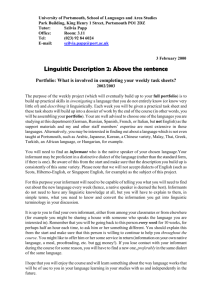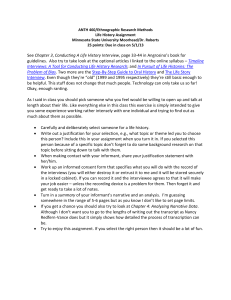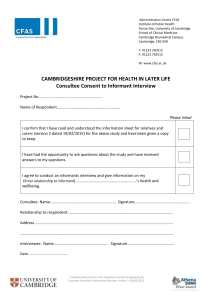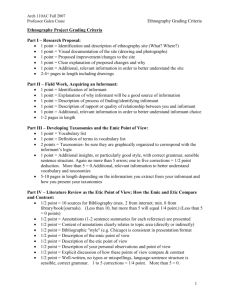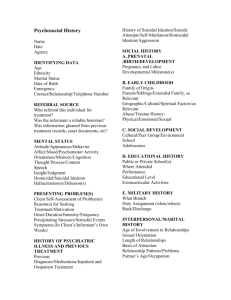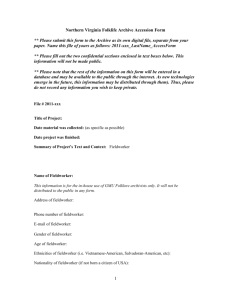A110ACfa05_Cranz_syl - College of Environmental Design
advertisement
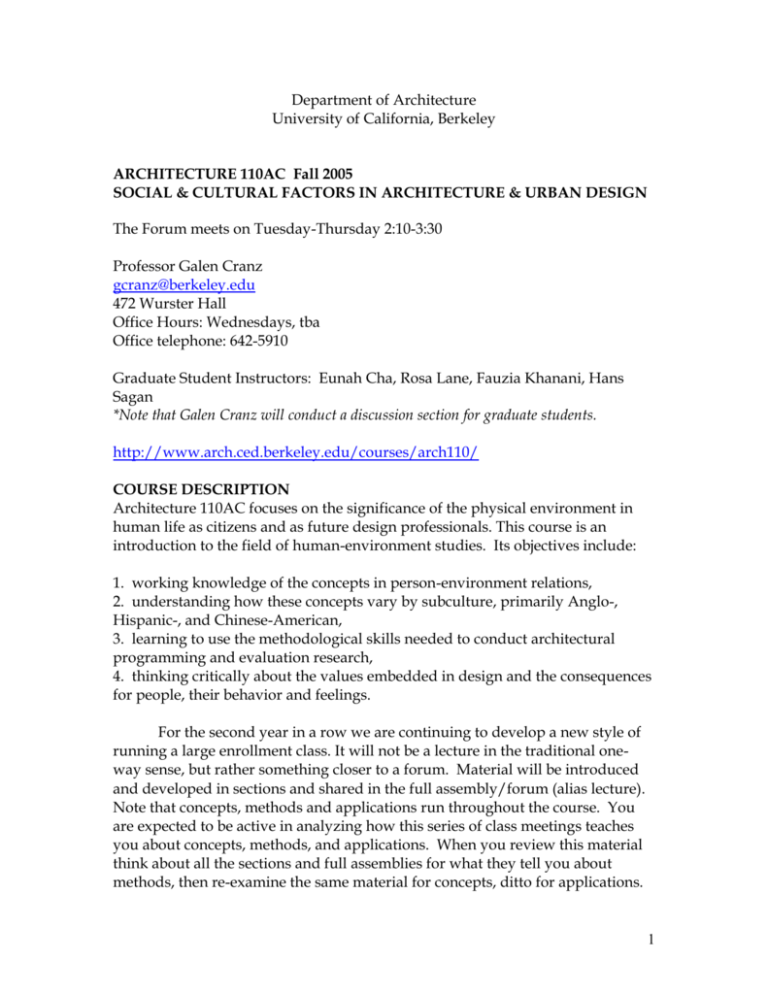
Department of Architecture University of California, Berkeley ARCHITECTURE 110AC Fall 2005 SOCIAL & CULTURAL FACTORS IN ARCHITECTURE & URBAN DESIGN The Forum meets on Tuesday-Thursday 2:10-3:30 Professor Galen Cranz gcranz@berkeley.edu 472 Wurster Hall Office Hours: Wednesdays, tba Office telephone: 642-5910 Graduate Student Instructors: Eunah Cha, Rosa Lane, Fauzia Khanani, Hans Sagan *Note that Galen Cranz will conduct a discussion section for graduate students. http://www.arch.ced.berkeley.edu/courses/arch110/ COURSE DESCRIPTION Architecture 110AC focuses on the significance of the physical environment in human life as citizens and as future design professionals. This course is an introduction to the field of human-environment studies. Its objectives include: 1. working knowledge of the concepts in person-environment relations, 2. understanding how these concepts vary by subculture, primarily Anglo-, Hispanic-, and Chinese-American, 3. learning to use the methodological skills needed to conduct architectural programming and evaluation research, 4. thinking critically about the values embedded in design and the consequences for people, their behavior and feelings. For the second year in a row we are continuing to develop a new style of running a large enrollment class. It will not be a lecture in the traditional oneway sense, but rather something closer to a forum. Material will be introduced and developed in sections and shared in the full assembly/forum (alias lecture). Note that concepts, methods and applications run throughout the course. You are expected to be active in analyzing how this series of class meetings teaches you about concepts, methods, and applications. When you review this material think about all the sections and full assemblies for what they tell you about methods, then re-examine the same material for concepts, ditto for applications. 1 The professor and the graduate student instructors in this course will function as consultants and facilitators, and expect you to be an active learner. You will have a partner in this learning process, an "art partner" and the two of you will function someone like study partners providing a sounding board for each other in response to the readings and assignments, and even further beyond this class to evaluate your studio work from the point of view of the social perspective you will develop in this class. You will also work in subgroups of four within your sections. In turn, the sections will function as active working groups for the forum as a whole. Your partner is called an “art” partner because this course uses social science methods and information in service of art. The ultimate goal is to create beautiful environments, and designed beauty is profound when it resonates with its culture. "Resonance" can be harmonious and it can also be a counterpoint, something new and improved. Using your artistic perception is an important first step in creating greater artistic harmony in the environment. Using oneself is the first step, but we must not forget to find out how many others share our perceptions. In this way personal and social approaches to the task of creating greater environmental beauty are related. In the first weeks the course introduces basic concepts that influence people's everyday experiences in their environment. Early on you will learn about data collection techniques for actually conducting a post occupancy evaluation. Your individual term project will begin after the POE for the last two thirds of the semester. Throughout the course and its various projects we ask you to consider how social factors influence the design and use of a wide variety of building and place types -- chairs, living rooms, housing, schools, playgrounds, campuses, parks, offices, neighborhoods, and streets. The two major research assignments introduce you to skills you will need as professional architects and designers. Through these two projects, you will learn to listen actively, observe systematically, interview sensitively, create meaningful questionnaires, and then how to translate what you learn into design concepts. The assignments and discussions seek to stimulate your capacity for both individual and team work. We intend that you will use these approaches to inform and inspire the designs you create in studio and beyond. That is, we do not see social factors as an ethical constraint, nor as a technocratic limitation on artistic freedom, but rather as the basis for artistic expression and invention. MAJOR ASSIGNMENTS The format for the following projects is 8-1/2" x 11". Adapt all drawings, photos, charts, sketches, graphs, etc. to this format. All assignments, must be handed in at the beginning of section on the day they are due. A 2 Ethnographic Study for Developing a Program for Design Individual Project This assignment is organized into seven parts and a final report (part VIII) that simulates the actual processes you would use as a professional architect. Working in phases allows you to build upon the feedback you will receive from your GSI and classmates and gives you the opportunity to develop your knowledge about the cultural setting you are studying and to think in depth about a responsive architectural program and design. You will integrate all the parts into a single comprehensive final report. Each part of the ethnography project will be graded. Late or missing segments will affect your ultimate grade. Completing the project in phases gives you the opportunity to receive feedback and improve the paper for your final grade. Following is a description of each of the seven parts of the project: Part I: Research Proposal (Personal Point of View) For this segment of the project you are to describe briefly the cultural situation you have selected to study. In one page, provide a detailed written description of the physical setting based on your initial observations. In one or two additional pages include annotated plans and sketches, and/or photographs. Draw a second plan and sketches that describe how you propose to improve this physical setting. Explain the changes you would make and why. This is your personal point of view as developed by your architectural education to date. Because this is an American cultures class, please consider chosing a situation that can provide insight into one of America's ethnic subcultures. The foci of the course are Hispanic, Chinese, and Anglos, but you can pick other cultural groups. Select a topic with an eye to being able to review previously published research literature on this topic, but don't restrict yourself. If you study something that has never been written about before, you can find a more general category that it might be a part of for your literature review. Part II: Field Work: Acquiring an Informant You should focus on obtaining an informant and learning a basic knowledge of the culture you are studying through your informant. Your informant should be someone who knows a lot about the situation you are studying. Write a summary describing how you gained access to the situation, the process of selecting an informant, and establishing rapport. When interviewing your informant, remember to begin with basic "grand tour" questions (who, what, where, when). Be sure to ask for definitions and clarifications of what terms mean. 3 Part III: Developing Taxonomies and the Emic Point of View Present the vocabulary used by your informant(s) organized into the taxonomies implicit in their worldview. Begin by noting the terms your informant uses to describe the situation. Assemble these terms into a vocabulary list including definitions. If your informant(s) approve, you may use a tape recorder during your interviews. Next, based on the major categories your informant uses construct taxonomies using either tables or charts. Use the vocabulary lists to check that you are incorporating every term into the structures of meaning. If appropriate to your relationship with your informant, show him or her the hierarchies you have constructed to make sure your understanding is correct and to clarify questions. You will also want to note any observations and thoughts you may have about the structure of the behavior setting and culture. Use copies of your plans to record observations. Keep your observations separate from what you learn from your informant for later contrast and comparison. Some of you may choose to study the same situation from the point of view of two or more different ethnic groups who use the same place. You would each have different informants and would be expected to conduct your ethnographies separately, but for your final report you would be in a position to make interesting contrasts and comparisons about the worldviews of the different informants and their different subcultures in regard to the institution you are studying. For example, two or more of you might study a park or a hospital or market from the point of view of how it means different things to the different subcultures within it. Part IV: Literature Review and the Etic Point of View At this point in the project you will learn what others have written about the behavioral setting and cultural group you are studying. Use library resources to research and write a review of the relevant literature. Even if no one has studied your exact setting you will be able to make meaningful comparisons. For example, the study of a Jamaican grocery store could be compared to published research on neighborhood grocery stores, specialty grocery stores, Jamaican restaurants or Jamaican cultural centers. You will produce an annotated bibliography of 10 articles or books. Use MLA, APA, or Chicago Manual of Style for your bibliographic entries. Be sure to include variation by sub-cultures in your searches if that is relevant. In any case, comment on how others research compares and contrasts with yours. Part V: Comparing Points of View Armed with knowledge from your initial experiences in the field and your literature review, you will now go back to your cultural setting physically and mentally to re-examine the setting and to clarify questions from personal, emic, and etic points of view. Comment in writing on the differences and similarities 4 among the three points of view and report and summarize any additional insights from this site visit. Part VI: Program Development and Redesign By now you have enough cultural knowledge from your informant and from your literature review as well as the general concerns of humanenvironment studies to develop an architectural program with initial design concepts for the behavior settings that you have been studying. We are asking you to participate in developing a new standard for architectural programming that goes beyond square footages and adjacencies. One of the many advantages of this new type of document is that when new people join an architectural team, the document gives the new members access to the richness and rationale of the program for the project. Use a combination of words and visual images to describe the desired activities, separations, adjacencies, moods and any other details about spatial character. Translate the program you have created into physical consequences, designing a new setting or redesigning the existing behavior setting. You might imagine that the situation you have study has been -- heaven for bid -- burned and the owners want to rebuild. Do you rebuild exactly as it was because it suited the culture perfectly? If so, you will be able to justify rebuilding as it was-in cultural terms. More likely, you would make changes in order to accommodate their culture more satisfyingly than the current physical environment. Comment on the similarities and differences between what you did in Part I and in this final redesign. Had you brought etic ideas from architecture that missed emic ideas? Amplify. Would the emic perspective have been satisfied by your initial vision? Why or why not, and how? Part VII: Poster Next imagine that you need to communicate to a community group how you have come up with this architectural program and design proposal. The poster is an opportunity to present your project and gain some feedback from others besides your GSI. Your poster should include the cultural knowledge (perhaps the most important taxonomies) that helped you develop your architectural program. On 24"x 36" display boards, summarize your program and design. Use the presentation techniques that best suit your project drawings, photos, etc. The purpose of the poster is to communicate to others what you have done, and to give you experience in conveying complex information to clients and community groups. In each of the six sections students will vote on the top 3 poster boards to present in the class as a whole, 18 in total. Part VIII: Final Report 5 The final report is a comprehensive edited version of all of the previous written reports (I-VII). Take this opportunity to make improvements in writing style including transitions and grammar, scholarly mechanics including footnotes and bibliography, better analysis, better graphics. Your GSI will have made editorial comments on your previous drafts, so make sure that you respond to them before you turn in your final report. This year we have given you the entire reading week at the end of term to make sure that you have time to improve your draft. B Post-Occupancy Evaluation (Small Group Project) At the beginning of the semester the class will be working together on collecting data for a Post-Occupancy Evaluation of a local building (Hearst Gymnasium). While everyone will be responsible for collecting some part of the data, you will work in small groups of 4 to analyze the data and present your findings in a report. The general strategy will be outlined in the forum and the details of your study organized in sections. GRADING Attendance in Section and Participation in Forum Reading Responses Ethnographic Study Post-Occupancy Evaluation 20% 20% 40% 20% Attendance and Participation Attendance and participation are required at all full group and discussion sections. Your section leader will take roll. These are important aspects of your learning experience and are valuable for fully synthesizing knowledge into skill. To participate fully you will have to have done the reading in advance of the section meeting. Participation means that you come to class, communicate (talk) with your partner and the rest of your section (which you can think of as your research team). You will sit with your section in the forum. Participation also means that your fill out forms, turn in small in-class exercises. You and your "art partner" are invited to sign up for office hours with Professor Cranz at least one time during the semester. When you work in teams you will evaluate the contribution of each member of your team, so there is also a peer component of this part of your grade. Ethnography 6 The various components of the ethnographic study are due as scheduled in the course syllabus, which follows. Each component will be graded, but you have the opportunity to continue to expand and improve your project throughout the semester. A single letter grade will be given for the total report and program at final grading. Students can work in pairs as long as separate reports are written and different informants are used. Please comment on the differences and similarities in the points of view of each informant. This could be an opportunity to study different subcultures within a larger institution. Post-Occupancy Evaluation The Post-Occupancy Evaluation is a class project where you will work in small groups of 4. Each group will receive a single grade for their group's report. Peer evaluation will be a part of this grade. Workload Since this is a 4-unit course, reading and written assignments outside of class meeting times are expected to take an additional 8 hours per week. We assume that your reading will take approximately half of your time, and your research projects will take the other half. We have assumed that you can read 20 to 35 pages per hour, which translates to 80 to 140 pages per week, or 40-60 pages per forum. We have been sensitive to the difficulty or ease of the reading in making the assignments. NO LATE WORK WILL BE ACCEPTED WITHOUT PRIOR APPROVAL—NO EXCEPTIONS. DISCUSSION SECTIONS Discussion sections are required and they begin in week two. Each section meets once a week for 1 1/2 hours. Please show respect for your GSI and fellow students by arriving on time. Graduate Student Instructors: Eunah Cha Rosa Lane Fauzia Khanani Hans Sagan eunahcha@berkeley.edu rosalane@earthlink.net fkhanani@berkeley.edu hanssagan@sbcglobal.net GSI Office: 472 Wurster Hall (GSI office hours will be held at this location unless otherwise stated by GSI) GSI Office Hours: tba 7 Section Schedule: Section 101 Section 102 Section 103 Section 104* Section 5 Section 6 Monday, 9:30-11 Monday, 11-12:30 Tuesday, 12:30-2 Monday, 11-12:30 Tuesday, 12:30-2 Tuesday, 9:30-11 Wurster Wurster Wurster Wurster Wurster Wurster Fauzia Khanani Eunah Cha Rosa Lane Galen Cranz* Hans Sagan Rosa Lane *Graduate student section REQUIRED COURSE MATERIALS Cranz, Galen. The Chair: Rethinking Culture, Body, and Design. New York: W.W. Norton, paperback 2000. Available at ASUC bookstore, Ned’s Berkeley Bookstore. Course Reader (3 Volumes). Available at Copy Central on Bancroft . Volume 1 and Volume 2 are readings selected for each forum topic, and Volume 3 "Ethnography and Space" is the guide for your ethnographic research project. 8
